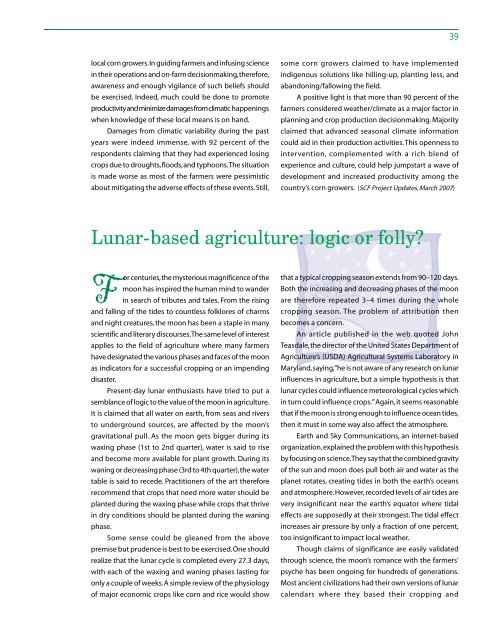Read More - Philippine Institute for Development Studies
Read More - Philippine Institute for Development Studies
Read More - Philippine Institute for Development Studies
You also want an ePaper? Increase the reach of your titles
YUMPU automatically turns print PDFs into web optimized ePapers that Google loves.
39<br />
local corn growers. In guiding farmers and infusing science<br />
in their operations and on-farm decisionmaking, there<strong>for</strong>e,<br />
awareness and enough vigilance of such beliefs should<br />
be exercised. Indeed, much could be done to promote<br />
productivity and minimize damages from climatic happenings<br />
when knowledge of these local means is on hand.<br />
Damages from climatic variability during the past<br />
years were indeed immense, with 92 percent of the<br />
respondents claiming that they had experienced losing<br />
crops due to droughts, floods, and typhoons. The situation<br />
is made worse as most of the farmers were pessimistic<br />
about mitigating the adverse effects of these events. Still,<br />
some corn growers claimed to have implemented<br />
indigenous solutions like hilling-up, planting less, and<br />
abandoning/fallowing the field.<br />
A positive light is that more than 90 percent of the<br />
farmers considered weather/climate as a major factor in<br />
planning and crop production decisionmaking. Majority<br />
claimed that advanced seasonal climate in<strong>for</strong>mation<br />
could aid in their production activities. This openness to<br />
intervention, complemented with a rich blend of<br />
experience and culture, could help jumpstart a wave of<br />
development and increased productivity among the<br />
country’s corn growers. (SCF Project Updates, March 2007)<br />
Lunar-based agriculture: logic or folly<br />
For centuries, the mysterious magnificence of the<br />
moon has inspired the human mind to wander<br />
in search of tributes and tales. From the rising<br />
and falling of the tides to countless folklores of charms<br />
and night creatures, the moon has been a staple in many<br />
scientific and literary discourses. The same level of interest<br />
applies to the field of agriculture where many farmers<br />
have designated the various phases and faces of the moon<br />
as indicators <strong>for</strong> a successful cropping or an impending<br />
disaster.<br />
Present-day lunar enthusiasts have tried to put a<br />
semblance of logic to the value of the moon in agriculture.<br />
It is claimed that all water on earth, from seas and rivers<br />
to underground sources, are affected by the moon’s<br />
gravitational pull. As the moon gets bigger during its<br />
waxing phase (1st to 2nd quarter), water is said to rise<br />
and become more available <strong>for</strong> plant growth. During its<br />
waning or decreasing phase (3rd to 4th quarter), the water<br />
table is said to recede. Practitioners of the art there<strong>for</strong>e<br />
recommend that crops that need more water should be<br />
planted during the waxing phase while crops that thrive<br />
in dry conditions should be planted during the waning<br />
phase.<br />
Some sense could be gleaned from the above<br />
premise but prudence is best to be exercised. One should<br />
realize that the lunar cycle is completed every 27.3 days,<br />
with each of the waxing and waning phases lasting <strong>for</strong><br />
only a couple of weeks. A simple review of the physiology<br />
of major economic crops like corn and rice would show<br />
that a typical cropping season extends from 90–120 days.<br />
Both the increasing and decreasing phases of the moon<br />
are there<strong>for</strong>e repeated 3–4 times during the whole<br />
cropping season. The problem of attribution then<br />
becomes a concern.<br />
An article published in the web quoted John<br />
Teasdale, the director of the United States Department of<br />
Agriculture’s (USDA) Agricultural Systems Laboratory in<br />
Maryland, saying, “he is not aware of any research on lunar<br />
influences in agriculture, but a simple hypothesis is that<br />
lunar cycles could influence meteorological cycles which<br />
in turn could influence crops.” Again, it seems reasonable<br />
that if the moon is strong enough to influence ocean tides,<br />
then it must in some way also affect the atmosphere.<br />
Earth and Sky Communications, an internet-based<br />
organization, explained the problem with this hypothesis<br />
by focusing on science. They say that the combined gravity<br />
of the sun and moon does pull both air and water as the<br />
planet rotates, creating tides in both the earth’s oceans<br />
and atmosphere. However, recorded levels of air tides are<br />
very insignificant near the earth’s equator where tidal<br />
effects are supposedly at their strongest. The tidal effect<br />
increases air pressure by only a fraction of one percent,<br />
too insignificant to impact local weather.<br />
Though claims of significance are easily validated<br />
through science, the moon’s romance with the farmers’<br />
psyche has been ongoing <strong>for</strong> hundreds of generations.<br />
Most ancient civilizations had their own versions of lunar<br />
calendars where they based their cropping and










